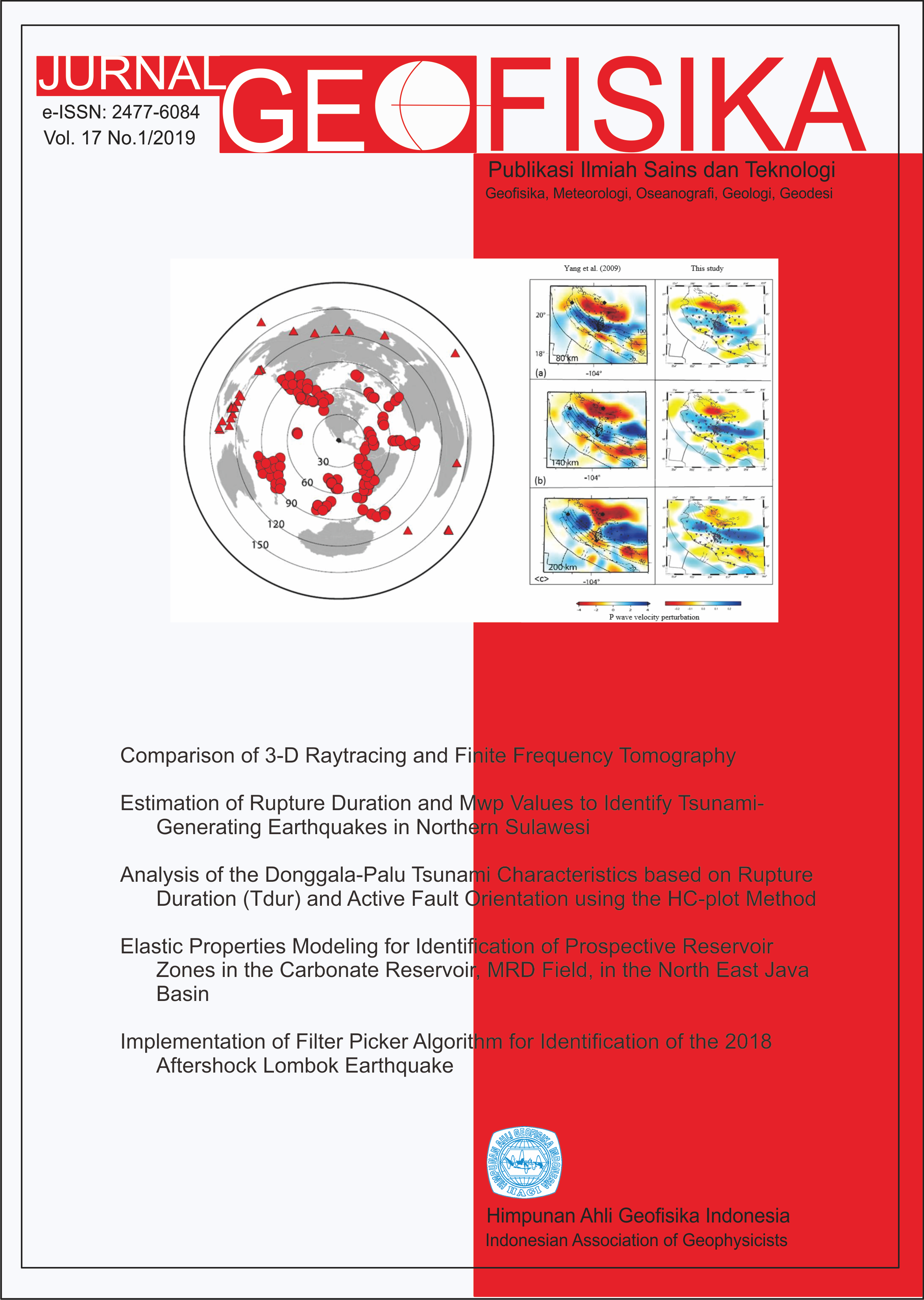Analysis of the Donggala-Palu Tsunami Characteristics based on Rupture Duration (Tdur) and Active Fault Orientation using the HC-plot Method
Keywords
rupture, Tdur, fault, HC-plotAbstract
September 28th, 2018, Donggala-Palu earthquake M 7.5 occurred at depth of 12 km and generated tsunami to be released off the coast in Palu Bay. The tsunami that occurred in Palu was very interesting because the results of the earthquake source mechanism Palu had a type of strike-slip fault that should not have generated a tsunami. This study purpose to estimate the characteristics of the Donggala-Palu tsunami based on rupture duration ( and orientation fault activated using the HC-plot method. The data used in this study are data waveforms from 17 seismic stations and CMT Global catalog data with the area of research 0.87 0 N-1.78 0S dan 118.640E- 120.95 0E. The waveform data used is a phase P-PP vertical component signal with a Bandpass-filter 1-5 Hz for determination . The fastest rupture duration from the earthquake source is obtained from the calculation of each station. Delay time measurement after P wave for 90% (T0.9), 80% (T0.8), 50% (T0.5), dan 20% (T0.2) from its peak value. Then the HC-plot method is used to estimate the orientation of generator fault Palu earthquake and the direction of rupture from the focal mechanism. From the results of processing obtained 2 pairs of seismic stations with almost the same distance but with different azimuths. The fastest rupture duration is at BBSI station with value of 82.014 s and distance from station to epicenter . So that the rupture direction is in the azimuth from the north. The result of fault orientation was obtained hypocenter distance to the centroid for nodal plane 1 is 6.32 km and nodal plane 2 is 30.17 km with distance centroid to hypocenter is 31.22 km. So in Palu earthquake, the tsunami generator fault was in nodal plane 1 with direction north-south. Criteria obtained indicate that the Palu earthquake M 7.5 has potential for a tsunami because of its value has meet ≥ 65 s, but from the result of the focal mechanism direction field not passing through the Palu bay is thought to be another parameter that generates a tsunami and Palu koro fault line uncharted.
References
Ibrahim, G., Subardjo, dan Senjaya, P., 2010. Tektonik dan Mineral di Indonesia. Jakarta, Puslitbang BMKG.
Lomax, A., dan Michelini, A., 2011. Tsunami early warning using earthquake rupture duration and P-wave dominant period: the importance of length and depth of faulting.Geophysical Journal International, 185(1), 283–291.
Lomax, A., dan Michelini, A., 2012. Tsunami early warning within 5 minutes. Pure and Applied Geophysics, 169.
Madlazim, dan Hariyono, E., 2014. Joko Tingkir program for estimating tsunami potential rapidly. In AIP Conference Proceedings (Vol. 1617, pp. 57–59). AIP.
Madlazim, M., 2011. Estimasi Durasi, Arah Dan Panjang Rupture Serta Lokasi-Lokasi Gempa Susulan Menggunakan Perhitungan Cepat. Jurnal Penelitian Fisika Dan Aplikasinya (JPFA), 1(2), 8–18.
Nakamura, Y., 1988. On the urgent earthquake detection and alarm system (UrEDAS). In Proc. of the 9th
World Conference on Earthquake Engineering (Vol. 7, pp. 673–678). Tokyo-Kyoto Japan.
Pasau, G., dan Tanauma, A., 2011. Pemodelan Sumber Gempa di Wilayah Sulawesi Utara Sebagai Upaya Mitigasi
Bencana Gempa Bumi. Jurnal Ilmiah Sains, 11(2), 202–209.
Pribadi, S., Puspito, N. T., Yudistira, T., Afnimar, Ibrahim, G., Laksono, B. I., dan Adnan, Z., 2014. Identification
of earthquakes that generate tsunamis in Java and Nusa Tenggara using rupture duration analysis. In AIP Conference Proceedings (Vol. 1617, pp. 116–119). AIP.
Walpersdorf, A., Vigny, C., Subarya, C., dan Manurung, P., 1998. Monitoring of the Palu-Koro Fault (Sulawesi) by
GPS. Geophysical Research Letters, 25(13), 2313–2316.
Zahradnik, J., Gallovic, F., Sokos, E., Serpetsidaki, A., dan Tselentis, A., 2008. Quick fault-plane identification by a
geometrical method: Application to the Mw 6.2 Leonidio earthquake, 6 January 2008, Greece. Seismological Research Letters, 79(5), 653–662.

This work is licensed under a Creative Commons Attribution 4.0 International License.
The copyright of all articles belongs to the authors. All other copyrights is held by the Journal











